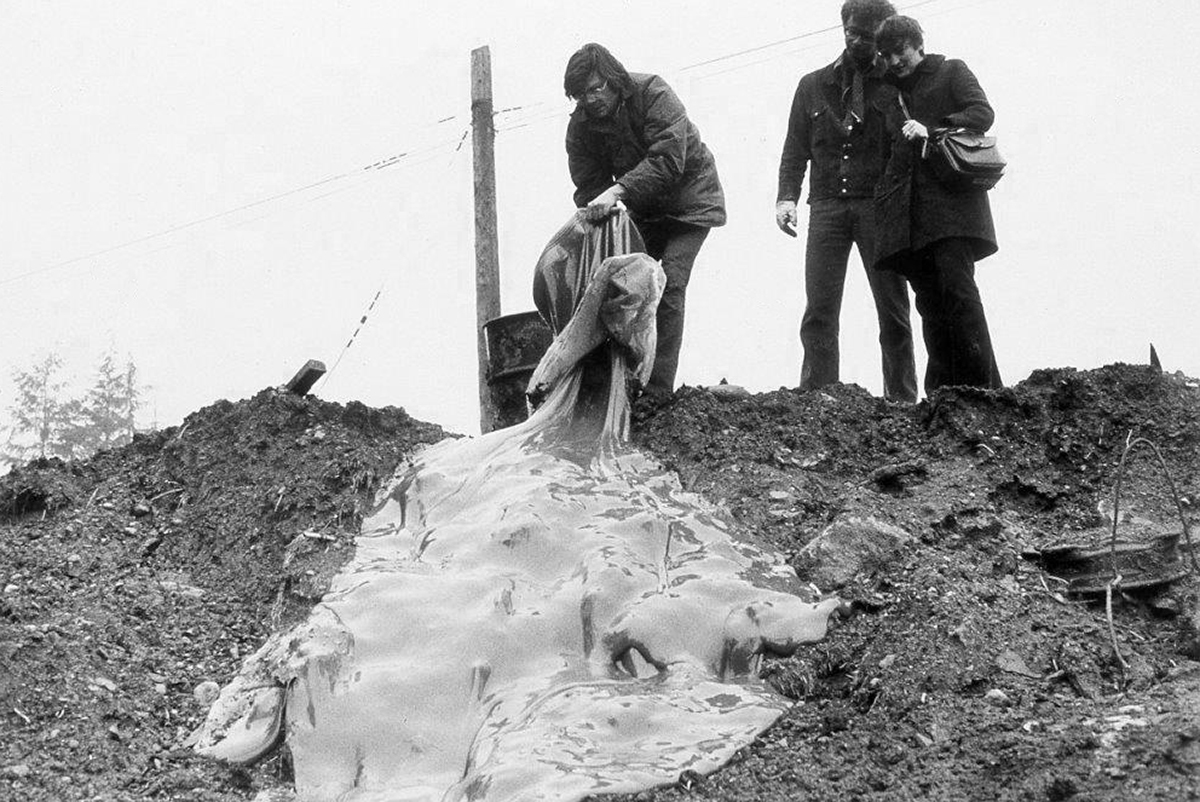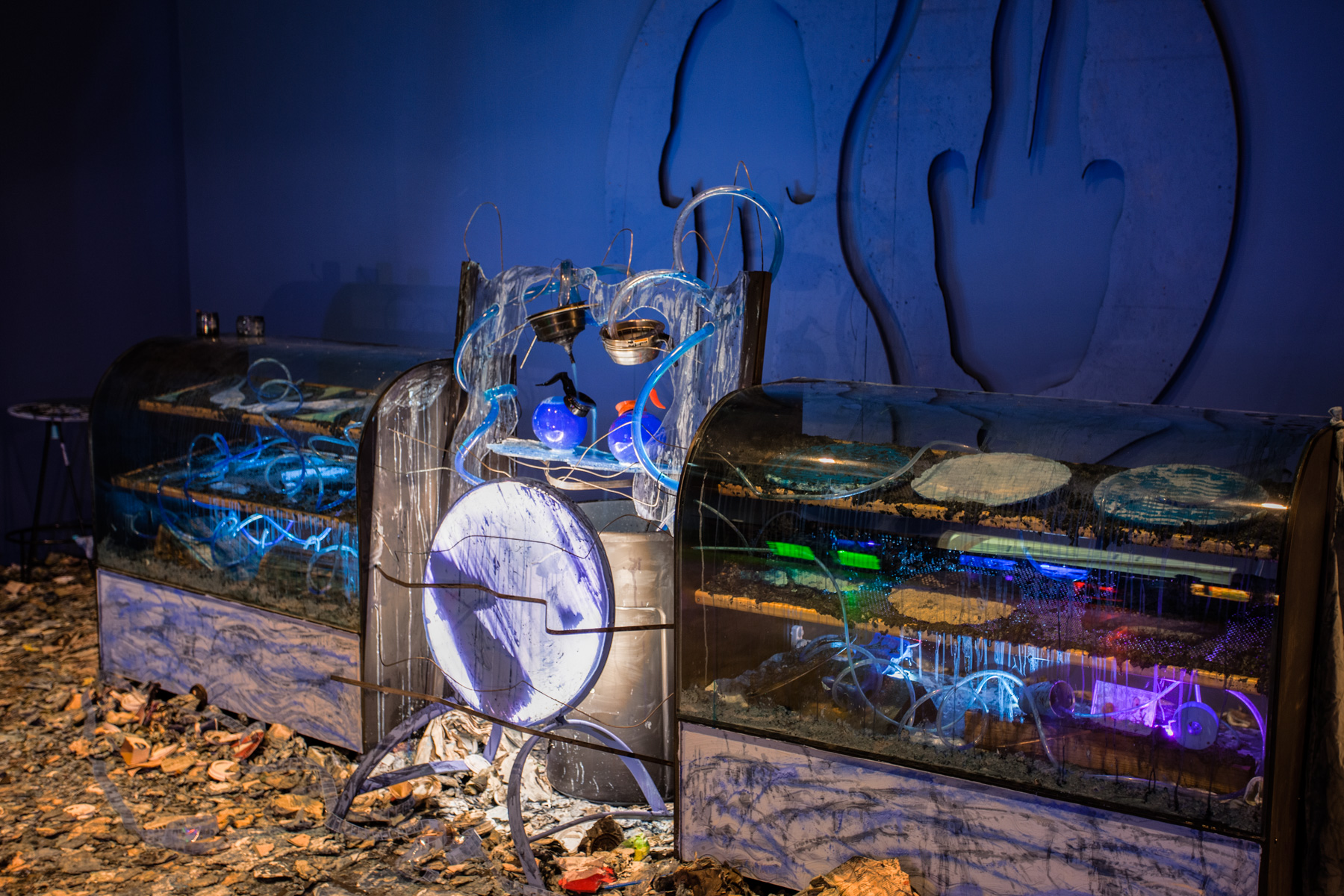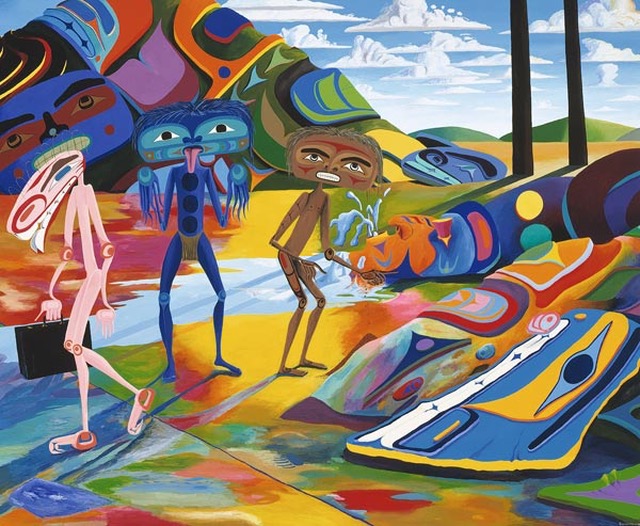
Robert Smithson, Glue Pour, 1970. (From left), Robert Smithson, Duane Lunden and Lucy Lippard. Photo: Christos Dikeakos.
In 1970, the Vancouver Art Gallery hosted an exhibition curated by Lucy Lippard titled 955,000, a figure that reflected Vancouver’s population at the time. Lippard’s project was highly dematerialized, idea-based art that was coming off gallery walls and claiming new sites. It was a year after Harold Szeeman’s exhibition at the Kunsthalle Bern, When Attitudes Become Form, and Lippard’s show included many of the same artists, strengthened by locals like Jeff Wall and Christos Dikeakos. Robert Smithson realized the work Glue Pour, an anti-form industrial deluge. I posit Lippard’s exhibition as a moment that exposed Vancouver to the conceptualism that continues to ground art in the city today: a materialist approach to history, the practice of siting objects to implicate their environment and an opposition to the faces of capital remains active.
The exhibition Kitchen Midden, curated by artists Anne Low and Gareth Moore, is drawn from the collections of Vancouver artists.1 It suggests common philosophical interests through the presentation of domestic items, arranged on sculptural plinths and on wall paintings. Historical lineages emerge, especially the instigators of the Western Front; an artist-run centre built by conceptually driven communers, on a diet of Fluxus. Founded in 1973, it has been a breeding ground for radical perspectives on environmentalism, the social body, and systems of value. Art as life was principal. The Fluxus artist Robert Filliou made performances there. Objects selected for this Midden are culled from these intellectual corners: vessels, figures, rocks are shared in contemplative revelry. Their aesthetics resonate with successive West Coast makers.

Julia Feyrer and Tamara Henderson. The Last Waves, 2016. Installation view, Morris and Helen Belkin Art Gallery. Photo: Michael R. Barrick.
Vancouver artists have a long engagement with the social history of art, and production and distribution continue to be a concern. However, compared to the philosophical clarity of our conceptual photographers, say Jeff Wall or Stan Douglas, today’s artworks are breaking down into poetic fragments. Utilizing symbolic systems in imaginative forms, the current generation of artists express themselves in multiple dimensions: creating materially determined, socially charged, aesthetically challenging constructions. This may be most evident in The Last Waves, an exhibition by Julia Feyrer and Tamara Henderson at the Morris and Helen Belkin Gallery. This immersive exhibition harnesses a playful use of psychology and scientific enquiry for expansive sculptures. These near-archeological sites (apartment building, bar, lab, Internet) explore the artists’ internal reflections. Social and environmental concerns are raised through a bricolage of urban waste, held up as relics and surrounded, thus exonerated, by essential compounds. The artists’ references are subjective and tangential, but themes of reckoning, digestion, and healing emerge. The work Communicating Vessels: Galactic Glass Healer (2016), made at the University of British Columbia’s chemistry lab, acts as a central conduit to channel these processes.
As late capitalism feels increasingly too late, it was apt when Noam Chomsky pointed out that the world’s indigenous people are on the forefront of environmental activism. Colonialist persecution, resource erosion and a need for a sensible relationship to the land are core issues for Vancouver’s indigenous artists. Currently, three exhibitions by local First Nation elders go straight to these points: Lawrence Paul Yuxweluptun’s Unceded Territories, Edgar Heap of Birds’s Genocide and Democracy, and Marianne Nichols’s Oh, How I Long For Home. Committed to the potential of art, they have picked it up as a weapon.

Lawrence Paul Yuxweluptun. The Impending Nisga’a Deal. Last Stand. Chump Change, 1996. Acrylic on canvas; 201 x 245.1 x 5.1 cm, Courtesy of Macauley and Co., Collection of the Vancouver Art Gallery. Vancouver Art Gallery Acquisition Fund.
Recently Lucy Lippard shared her research in a lecture at Simon Fraser University. Vancouver’s population is now 2.467 million. Lippard’s project continues, as she has done for over a decade, to call for an activist art. Her lecture presented images of environmental collapse. Calmly critical about the spectacular status of land art sites, she suggested dematerialization could go further to actually reach into our social fabric. She identified “social energies not yet recognized as art.” Agitprop protests by indigenous groups lead this charge, Lippard shared their accomplishments. Environmental devastation is a global concern, even if action must be local. Modernist autonomy has long cast its shadow here, but considering Vancouver’s historically strong concerns for social welfare and the current modes of expanding artistic forms, young artists may be candidates to push beyond the solitary commodity. Lippard has been living off the grid for more than twenty years; her position on material consumption is clear. If her influence resonates as profoundly as it did in 1970, artists may take up her call and continue the long march beyond the individual art form to articulate their artistic and social values.
This Place Issue is a discursive look at two of the cities recently profiled by Art21, and includes articles on Vancouver and Chicago. Selected to emphasize variety, location is a focusing lens through which to enter contemporary art activities in these distinct, if parallel, art cities. History is usually geographical and artists turn to their cultural past in evolving their formal vocabularies and locating their art within specific issues. In addition to the dispatches from the coast, the team on the ground in Chicago will bring multiple perspectives from their vantage point. They, like artists in Vancouver, are looking around them to locate things in resonate ways. These two places, while both essentially outside the centre, have consistently been a part of the larger conversation. Similarly distinguished by the excellence of their art schools, this issue is a glimpse into these equally articulate and active art communities today.
1. Full disclosure, I am Director of Griffin Art Projects where this exhibition is presented, and chose to discuss this project as it is deeply engages with our shared artistic history, organized by artists of this generation.



